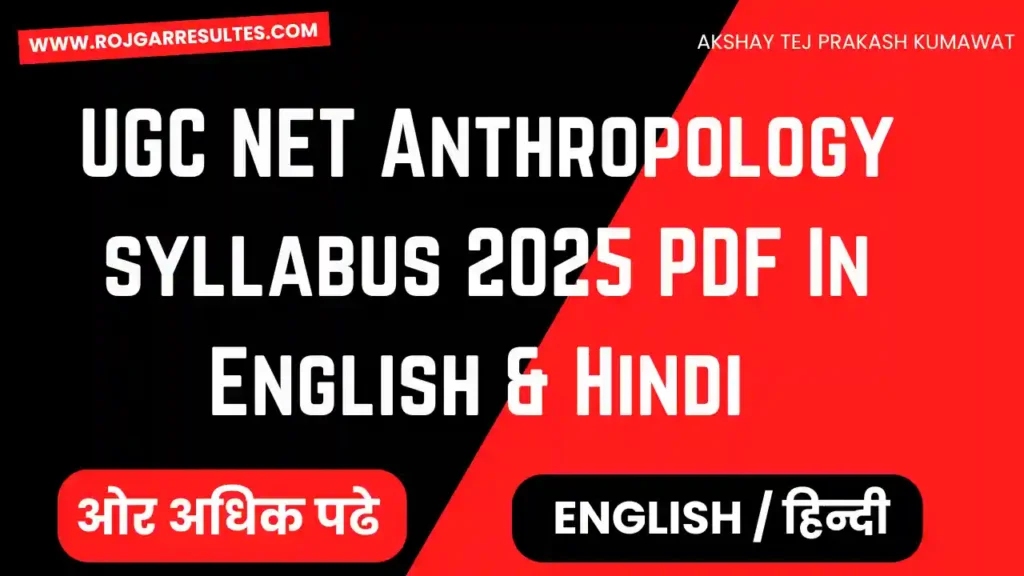UGC NET Anthropology Exam 2025 requires a deep understanding of the exam pattern. Anthropology, being a multidimensional subject, spans biological, social, cultural, and archaeological perspectives. This comprehensive guide will break down each unit of the syllabus, helping aspirants plan their preparation effectively.
सभी अभ्यर्थियों को सूचित किया जाता है कि रिजल्ट, सिलेबस, आवेदन लिंक, एडमिट कार्ड व नोटिफिकेशन के सभी लिंक नीचे उपलब्ध हैं।
Overview of the Ugc Net Anthropology Syllabus
- Paper I: General Paper on Teaching and Research Aptitude
- Paper II: Subject-specific paper
I: Fundamentals of Anthropology & Research Methods
Anthropology studies humans across time and space, exploring physical, social, and cultural dimensions. Key areas include:
- History, Development, Scope: Evolution of Anthropology, its aim, scope, and relationships with other sciences.
- Branches: Physical Anthropology, Cultural Anthropology, Archaeology, Linguistic Anthropology, and their interrelationships.
- Research Methodology:
- Concepts: Epistemology, Ontology, Theoretical Perspectives
- Types of Research: Qualitative & Quantitative
- Research Design & Hypothesis Formulation
- Fieldwork Methods: Ethnography, Observation, Interviews, Case Study, Life History, Focus Groups, PRA, RRA, Genealogical Method, Schedules, Questionnaires
- Advanced Techniques: Grounded Theory, Exploration, Excavation, GIS
- Statistics: Variables, Sampling, Central Tendency & Dispersion, Parametric & Nonparametric Tests, Regression Analyses
- Analysis Methods: Content Analysis, Discourse Analysis, Narrative Studies
II: Human Evolution and Primatology
Anthropology extensively studies human origins and evolutionary trends.
- Evolutionary Theories: Lamarckism, Neo-Lamarckism, Darwinism, Neo-Darwinism, Synthetic Theory, Neutral Theory, Punctuated Equilibrium
- Primates:
- Trends in Primate Radiation, Classification, and Distribution
- Morphological, Skeletal, Locomotion, and Social Behaviour Characteristics
- Extant Primates: Prosimii & Anthropoidea
- Human Evolution:
- Pre-hominids: Sahelanthropus, Orrorin, Ardipithecus
- Early Hominids: Australopithecus species
- Transitional Humans: Homo habilis, Homo erectus (Turkana boy, Java man, Peking man), Homo floresiensis
- Archaic sapiens: Homo heidelbergensis, Rhodesian Man, Narmada Man
- Neanderthals & Modern Homo sapiens: Distribution, Features, Dispersal Theories
III: Modern Human Variation & Genetics
Understanding biological diversity is crucial in Anthropology.
- Human Variation Models: Typological, Populational, Clinal
- Ethnic & Linguistic Classifications: Indian Population studies by Risley, Guha, Sarkar
- Genetics Methods: Cytogenetics, Mendelian, Twin & Sib Pair Studies, Population & Molecular Genetics
- Cytogenetics: Karyotyping, Banding, FISH, Chromosomal Abnormalities, Telomeres & Centromeres
- Inheritance Patterns: Autosomal, Sex-linked, Polygenic, Multifactorial
- Population Genetics: Hardy-Weinberg Equilibrium, Mating Patterns, Genetic Drift, Polymorphism
- Molecular Genetics: DNA, RNA, Protein Synthesis, SNPs, STRs, VNTRs, Mitochondrial DNA, Mutations
IV: Human Growth, Adaptation & Demography
- Growth & Development: Prenatal & Postnatal Phases, Growth Curves, Catch-up & Catch-down Growth
- Aging & Senescence: Somatic, Skeletal, Dental Maturation
- Human Adaptation: Allen’s & Bergmann’s Rules, Heat/Cold/Altitude Adaptation
- Somatotyping: Kretschmer, Sheldon, Parnoll, Heath-Carter
- Demography: Fertility, Mortality, Migration, Selection Intensity
Unit V: Prehistoric Archaeology
- Concepts & Theories: Ethno-archaeology, Cognitive Archaeology, Experimental Archaeology
- Dating Methods: Radiocarbon, Thermoluminescence, Potassium-Argon, Dendrochronology, Amino Acid Racemization
- Paleoenvironment: Geological Stages, Climatic Changes, Glacial & Interglacial Periods
- Lithic Tools & Cultures: Lower, Middle, Upper Paleolithic, Mesolithic, Neolithic
- Neolithic Sites: Jericho, Çatal Huyuk, Shanidar
VI: Prehistory in India
- Lower Paleolithic: Soan, Madrasian, Attirampakkam, Bhimbetka
- Middle & Upper Paleolithic: Belan Valley, Renigunta, Visadi
- Mesolithic: Bagor, Tilwara, Adamgarh, Sarai Nahar Rai
- Neolithic & Early Farming: Burzahom, Gufkral, Inamgaon, Maski
- Indus Civilization: Mohenjodaro, Harappa, Dholavira, Lothal
- Metal Ages & Megaliths: Copper/Bronze, Iron, Types of Megaliths
VII: Social & Cultural Anthropology
- Culture & Society: Holism, Universals, Acculturation, Civilization, Cultural Pluralism
- Social Institutions: Family, Marriage, Kinship
- Economic Anthropology: Production, Exchange, Reciprocity, Kula, Potlatch, Jajmani
- Religion & Belief Systems: Animism, Totemism, Witchcraft, Rituals
- Social Change: Assimilation, Integration, Syncretism, Dominance
VIII: Theories in Social Anthropology
- Evolutionism, Diffusionism, Historical Particularism, Functionalism
- Structuralism, Culture & Personality, Cultural Materialism, Symbolic Anthropology
- Cognitive Anthropology, Interpretive Anthropology, Postmodernism, Gender Studies, Ethnicity
IX: Development of Indian Anthropology
- Social Stratification & Movements: SC, ST, OBC, Tribal Movements
- Village Studies: S.C. Dube, M.N. Srinivas, McKim Marriott
- Constitutional Safeguards & Panchayati Raj
- Theoretical Ideas: Sanskritization, Westernization, Modernization, Sacred Complex
- Key Anthropologists: G.S. Ghurye, B.S. Guha, S.C. Dube, Iravati Karve, N.K. Bose, Verrier Elwin
X: Applied Anthropology
- Concepts: Action, Urban, Public, Medical, Visual, Forensic Anthropology
- Community Development: Rural, Urban, Tribal; Impact Assessment; NGO Roles
- Development Strategies: Women Empowerment, LGBT Inclusion, Nutrition, Education, Livelihood Programs
10 comprehensive units, covering physical, social, cultural, archaeological, and applied anthropology.


